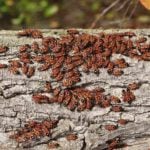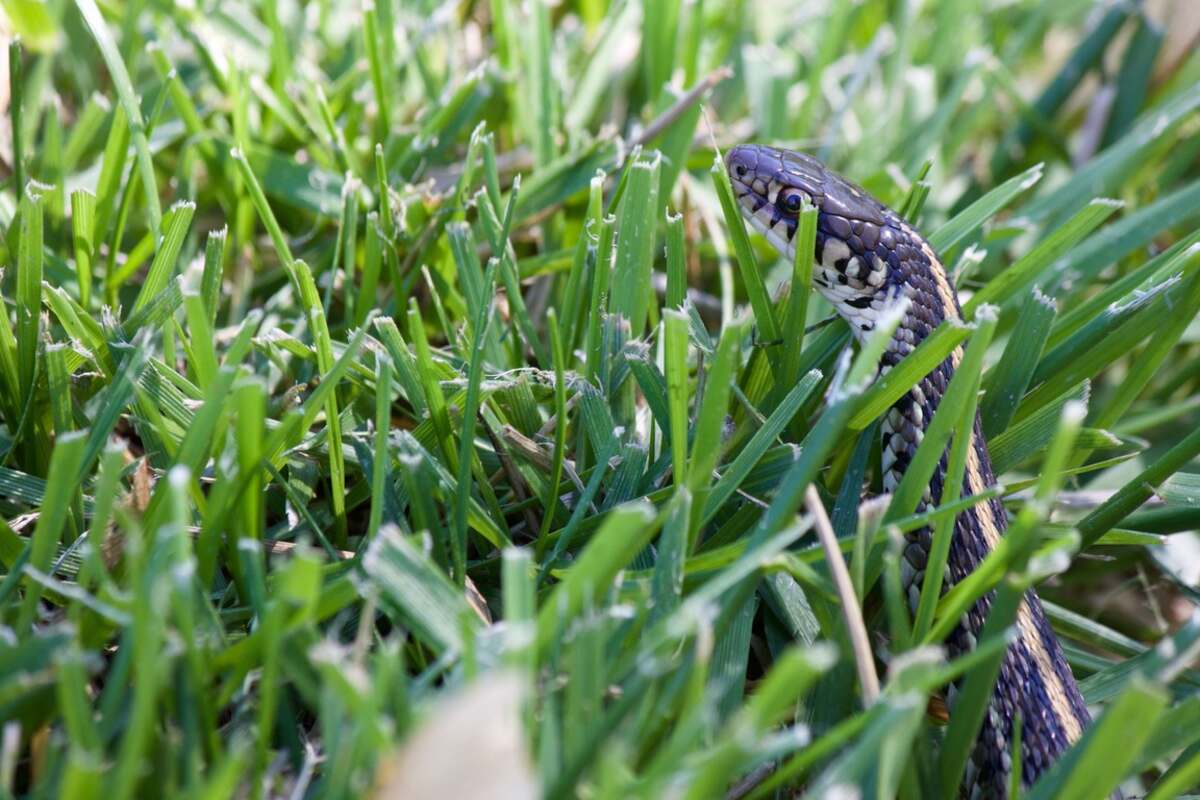
If you see a snake in your garden, you don’t want to panic. But you do want to decide what to do about it. “Most snakes pose no danger,” says Robert T. Mason, professor of integrative biology at Oregon State University. “Even if you see a snake, you’re very unlikely to get bitten.”
But there are concerns. You might have to get rid of the snake, or at least make it slither away. On the other hand, you might want to change the way you use your garden or the way your garden is setup. We’ll explain how to identify snakes and discourage snakes near your home, giving humans and reptiles the space each needs to thrive.
- Snakes Aren’t Killing a Lot of People
- Snakes in the Garden: Both Predator and Prey
- Non-Venomous vs. Venomous Snakes
- What To Do If You See a Snake in Your Garden
- What To Do If You Fear Seeing a Snake in Your Garden
- Snakes Are a Protected Species
- If You Don’t Want Snakes
- But If You Want Snakes …
- Snake Bites: An Overview
- If You Find a Snake Inside Your House
- When to Call In a Professional
- Fear of Snakes Is Common
- FAQs
Snakes Aren’t Killing a Lot of People
Death from poisonous snakes, called envenomation, is rare: An average of just six snake-bite fatalities occur annually. More people die from lightning strikes and hornet, bee, or wasp stings.
Source: UF Wildlife
Snakes in the Garden: Both Predator and Prey
Even the U.S. Army recognizes the value of snakes in the garden.
Snakes are a food source for:
- Mammals
- Other reptiles
Snakes feed on:
- Frogs and other amphibians
- Earthworms (especially common garter snakes)
- Lizards
- Slugs
- And other snakes
Snakes offer other benefits:
- They do not eat your plants.
- They do not eat your crops.
- They do not transmit disease to humans.
Non-Venomous vs. Venomous Snakes
Non-Venomous Snakes
Common garter snakes and other non-venomous snakes can be left to bask in the sunshine while you work in the garden or mow the grass, according to Adam Janke, an extension wildlife specialist at Iowa State University. Here are a few non-venomous snakes you should know:
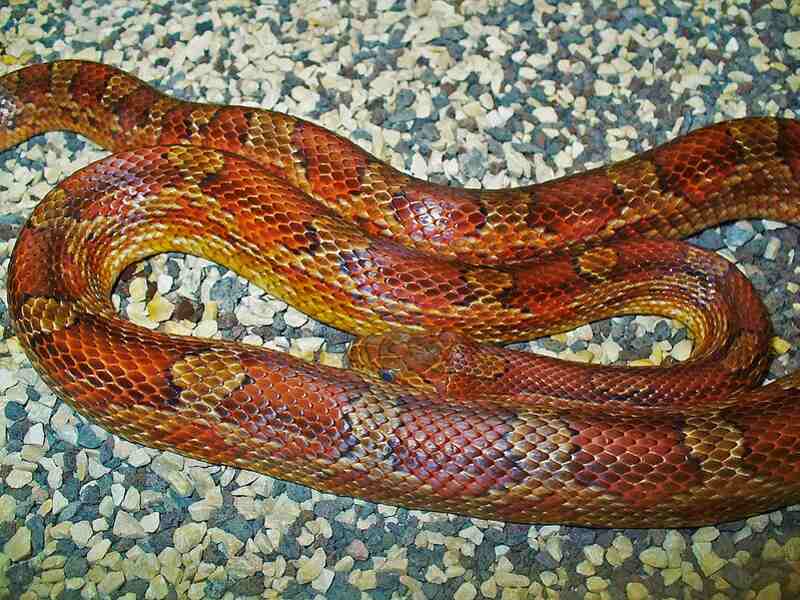
- Corn snakes (Pantherophis guttata). Fairly large (30-48 inches). Orange, reddish brown, brown, or gray with a lot of squarish black-margined brown or reddish blotches. Often mistaken for venomous copperheads, which have blotches in the shape of hourglasses and are browner in color.
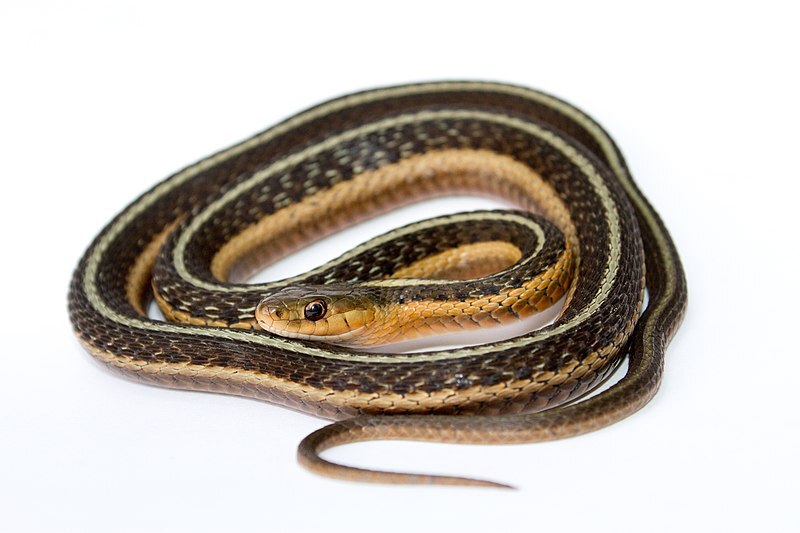
- Garter snakes (Thamnophis sirtalis). Thin, 2-4 feet in length. Commonly called “garden snakes.” Most garter snakes have yellow stripes on a black, brown, or green background. Garter snakes are the most common snake to be found in a North American garden. They are harmless to people, and do not have venom.
Garter snakes eat mice, amphibians, earthworms, and a few unwanted garden pests such as slugs. For this reason, many believe garter snakes are good for gardens and good to have in your yard.
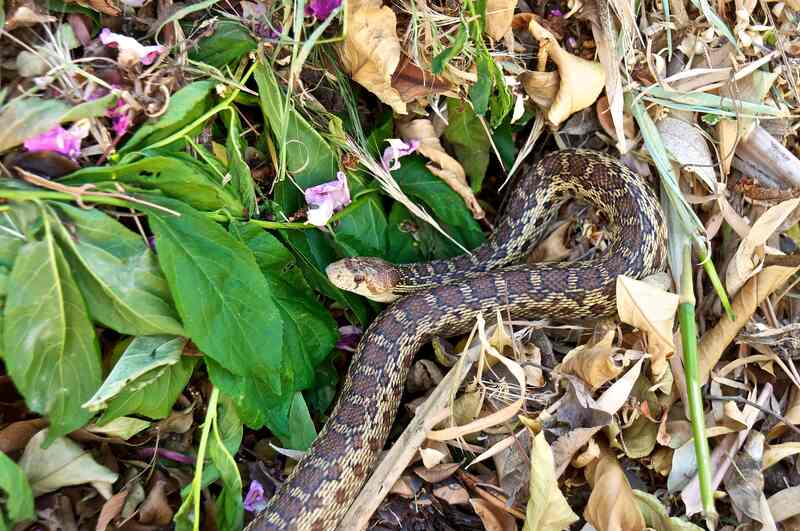
- Gopher snakes (Pituophis catenifer). Can be 3-7 feet in length. Yellowish or light brown, box-shaped markings along its back with a yellowish underside. When threatened, it shakes its tail like a rattlesnake, and also curls up like one, then strikes (but without fangs, it only bumps its adversaries, trying to knock them away).
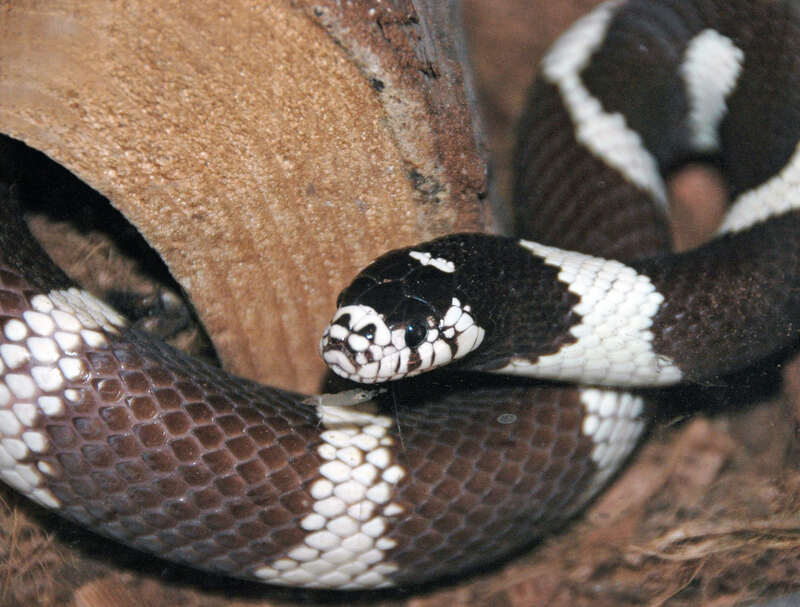
- Kingsnakes (Lampropelis getula). Large at 3-4 feet. Black with white or yellow bands that circle its body. Thrive in many habitats, from swamps to farmlands and suburban backyards. Feed on slugs. Secretive to the point of hiding under objects such as boards.
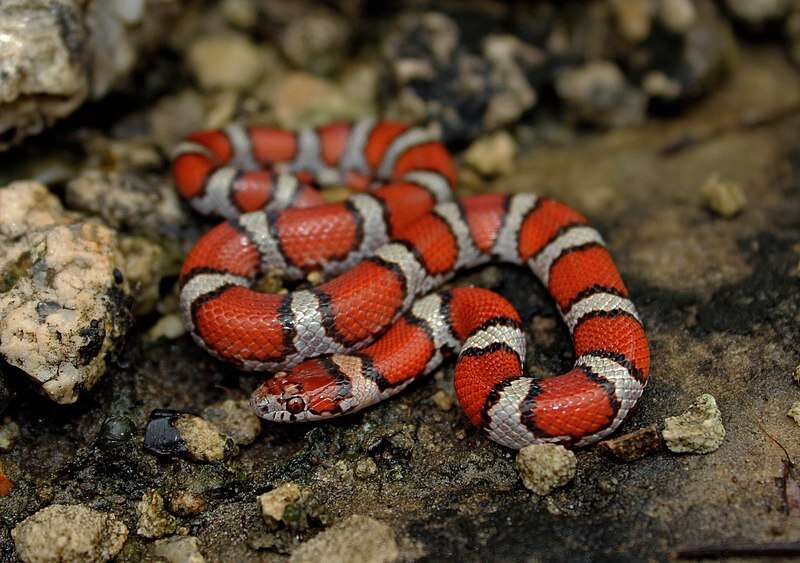
- Milk snakes (Lampropeltis triangulum). Medium size at 2-3 feet.Slender. Bright, bold colors. Known for scarlet or orange blotches with block circles around them. Can also have gray blotches inside the black circles. Found under rocks and logs in fields, savannahs, farms, wetlands, and the suburbs.
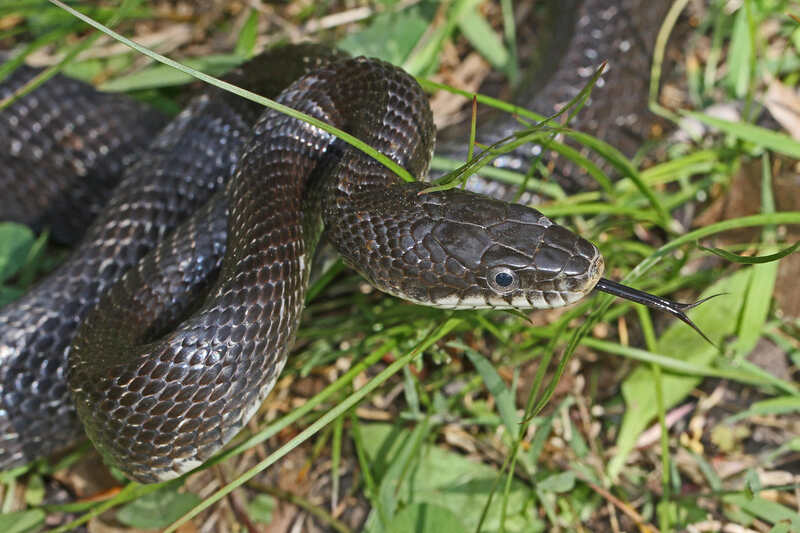
- Rat snakes (Pantherophis obsoleta). Mostly 3-5 feet in length, with some reaching 6 feet or more. Different ones are black, gray, or a combination of green, yellow, and orange. The underside is checkered or mottled approaching the tail. Rat snakes can climb tree trunks and brick walls.
Venomous Snakes
If you see one of these venomous snakes as you work in the lawn, keep your distance.
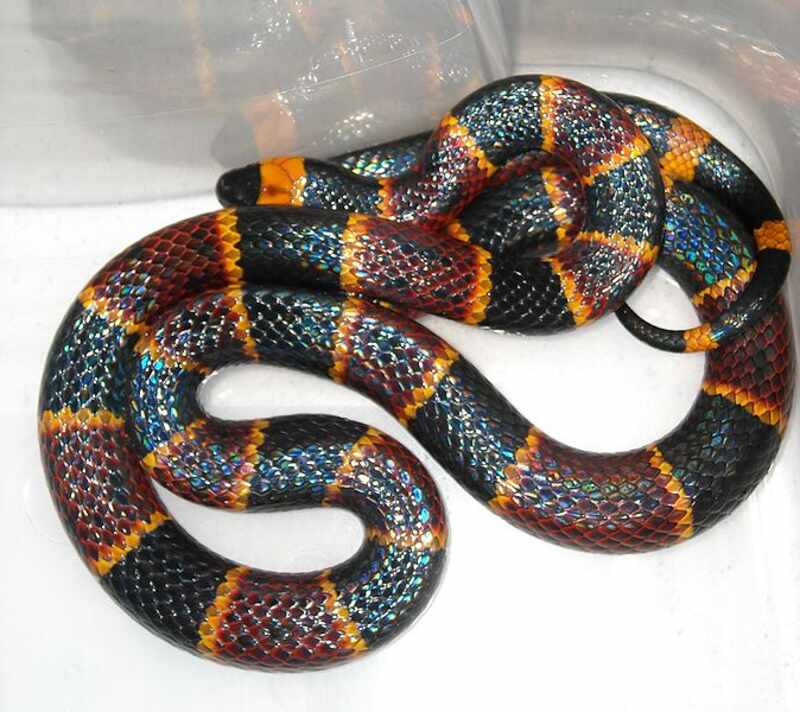
- Coral snakes (Micrurus fulvius). Usually 2 feet in length. Wide red and black bands with narrow yellow bands between. Found underground, in sandy soil. Similar in appearance to the non-venomous kingsnakes and scarlet snakes, which do not have the sharp yellow bands of the coral snake, leading to this saying: “Red on yellow can kill a fellow.”
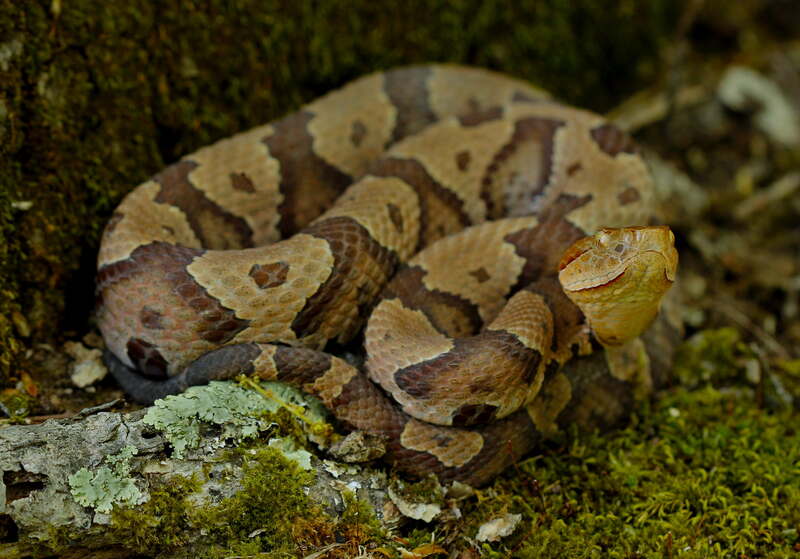
- Copperhead (Agkistrodon contortrix). Usually 2-3 feet in length but can reach 4 feet. Thick body. Coloring is pink to coppery-tan with dark brown, hourglass-shaped bands. Head is copper in color, giving the snake its name. The coloration provides serious camouflaging; that and its venomous bite make it a major concern to people.
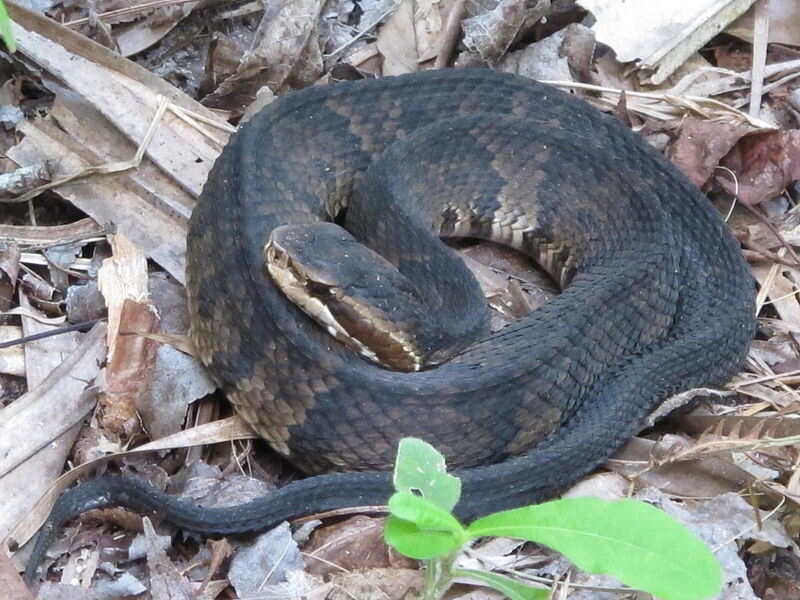
- Cottonmouth (Agkistrodon piscivorus). Large at 2 ½-3 ½ feet. Thick body. Dark olive-brown to almost black with dark crossbands. Inside of mouth is white, leading to the name. Also known as “water moccasins” for living in swamps and drainage ditches. Can be found by rivers and lakes. Can be seen swimming in the water.
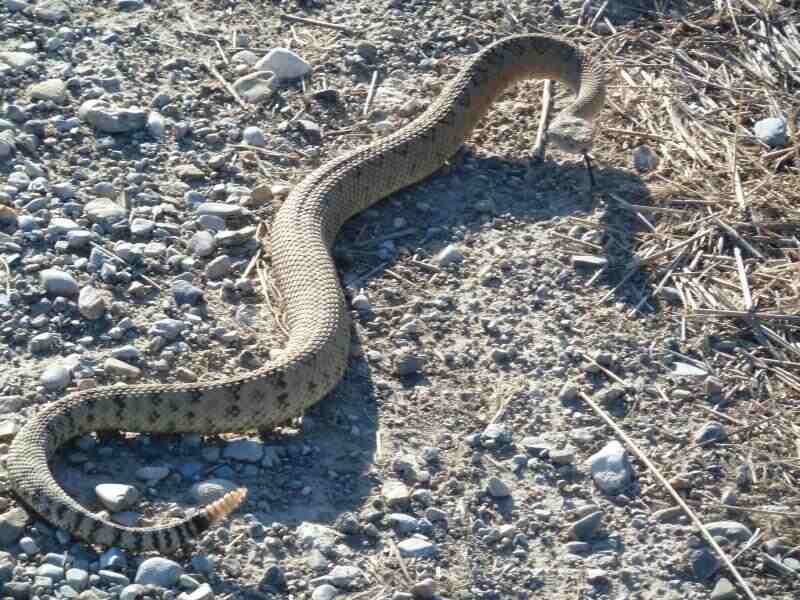
- Rattlesnakes (Genus Crotalus). From 2-5 feet. Heavy bodies. Bodies can be gray, black, brown, olive, or yellow with banded, diamond, or spotted patterns. Add rattles as they grow. Will defend itself when cornered. Can strike up to a body-length away, though since it would be coiled, you wouldn’t know how far that is.
What To Do If You See a Snake in Your Garden
- Give it space to move on.
- Snakes have a natural fear of people. They will avoid you, if you let them.
- Identify the snake. If it is venomous, it must be removed from your backyard. If it is a garter snake, it can be enjoyed. [Note: It’s wise not to get too close. If it’s safe to do so, maintain your distance and snap a photo. A local wildlife expert should be able to help you identify the snake.]
- Spray it with the garden hose. It is a nonlethal option to encourage it to go slithering away.
- Do not bring out the guns, shovels, or other weapons. Many snakes are protected species. Also, discharging a firearm toward the ground can result in bullet ricochet.
What To Do If You Fear Seeing a Snake in Your Garden
- Wear shoes, and ones that cover your toes.
- Wear long pants, not shorts.
- Garden gloves can be the gardener’s best friend. “Some venomous snakes, like copperheads, have short fangs, and garden gloves could offer enough of a barrier to prevent envenomation,” Mason says.
- Careful where you walk. If you step on a snake, it will likely bite you.
- Never reach into tall plants, a woodpile, or any place where you can’t see what might be there.
Snakes Are a Protected Species
You would have to be careful about killing a snake because so many kinds are protected. Individual states protect snakes, in addition to the ones protected on the federal level by the U.S. Fish and Wildlife Service.
The federally protected snakes include:
- Alameda whip snake
- Atlantic salt marsh snake
- Black pine snake
- Copper-belly water snake
- Eastern indigo snake
- Eastern Massasauga rattlesnake
- Giant garter snake
- Mona boa
- Narrow-headed garter snake
- New Mexican ridge-nosed rattlesnake
- Northern Mexican garter snake
- Puerto Rican boa
- San Francisco garter snake
As of this writing, all but the Puerto Rican boa and San Francisco garter snake are threatened, but these last two are endangered.
Source: U.S. Fish and Wildlife Service
The federal penalties for harming an endangered species of snake, such as the Puerto Rican boa and San Francisco garter snake, in your garden:
ENDANGERED SPECIES ACT PENALTY SCHEDULE
| First offense | Second offense | Third offense | |
| Kill | $3,500 | $7,500 | $13,000 |
| Wound/Injure/Hunt/Capture | $2,000 | $4,500 | $10,000 |
| Taking via Significant Habitat Modification or Degradation | Penalties to fit the facts and circumstances of a particular case up to the statutory maximum | Penalties to fit the facts and circumstances of a particular case up to the statutory maximum | Penalties to fit the facts and circumstances of a particular case up to the statutory maximum |
| Harass | $1,000-$10,500 | $2,000 | $7,500 |
| Collect Parts | $500-$2,000 | $1,000-$5,500 | $2,000-$10,500 |
Every state has protected at least a few kinds of snakes. Rough rule of thumb: Don’t kill them unless you are being attacked.
If You Don’t Want Snakes
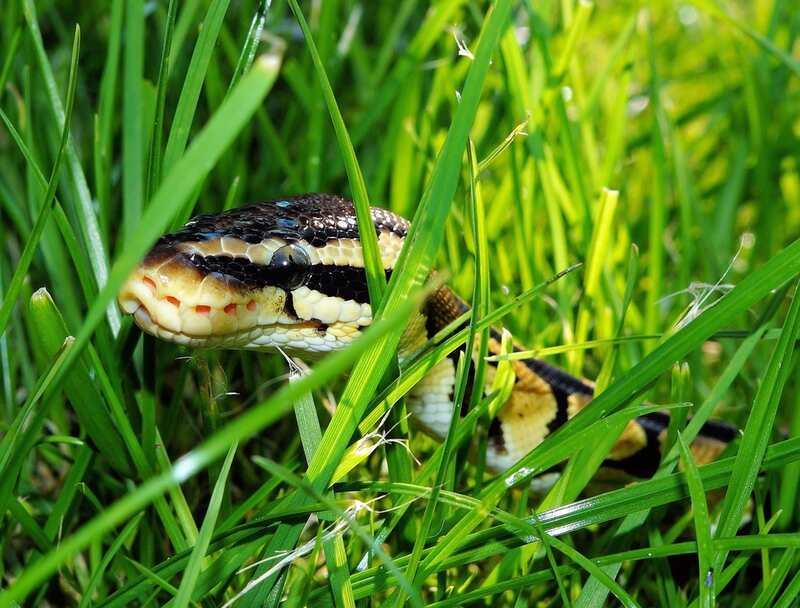
- Cut the grass. Snakes can hide in longer grass, not only from humans, but from such airborne predators as hawks. “A manicured lawn leaves the snake exposed,” Mason says.
- Secure the foundation. Snakes will slither through the smallest of openings in the foundation of the house in order to hide. Make it a point to close cracks and crevices around porches and steps. Make sure that the area where the foundation and the siding meet is secure.
- Remove wood piles. Snakes routinely take cover in wood piles. If you must have a pile of wood (say, to store the logs you will burn in the fireplace), put it as far from the house or pathways as you can.
- Be wary about cool, moist spots. Those areas under dense brush can be cool and moist, the kind of place that snakes like. If you don’t want snakes, you can trim the brush, or trim it up. If you want snakes but not near the house, make sure any bushes are moved to the fringes.
- Be careful about water features. Snakes are attracted to ponds, streams, and other water features as small rodents and small fish are prime food sources.
- Minimize hardscaping. Snakes are cold-blooded, so they warm themselves in the sun, and will turn up on stone patios, asphalt driveways, and similar places.
- Keep bird feeders away. Birds spill seed on the ground, which attracts mice and voles and then snakes. Keep any bird feeder away from your house, garage, or outbuilding.
- Store bird seed and pet food in a metal can with a tight lid if you keep it outside.
- Feed your pets inside. Their food will attract the small things that attract snakes. If you end up feeding pets outside, clean up right away.
- Think before you landscape. Mulch and large rocks (small rocks are OK) will attract snakes and provide breeding places. Water gardens and koi ponds are feeding spots for snakes.
But If You Want Snakes …
Gardeners who want to attract garden snakes should:
- Let the grass grow, especially around the fringes of the yard, to give garden snakes a safe spot to hide in your ecosystem.
- Place flat rocks in places that get sun. Or stack rock piles.
- Protect snakes from predators by discouraging cats from your yard and keeping any cat of yours indoors.
- Add small brush piles to serve as shelter and nesting sites.
Snake Bites: An Overview
If You Are Bitten by a Snake
Things you should do:
- Remain calm. If your blood races, it drives the venom through your body.
- Keep still. Movement will send the venom through your body.
- Do not eat or drink anything, especially alcohol or caffeine.
- Cover the bite with a proper dressing. Don’t improvise with a scarf; get a bandage.
- If bitten on an arm or leg, do not elevate above the heart. Keep the limb motionless and lower than the level of the heart.
- Call 9-1-1 without hesitation. Get to an emergency medical facility. Do this even if you believe you have been bitten by a non-venomous snake such as a garter snake; they can spread tetanus.
- Remember what the snake looked like. The description of the snake’s colors and markings will help the medical people determine which treatment to use. There are differences.
- Remove rings, watches, and constrictive clothing, in case of swelling.
- Note the time when the bite occurred. It can matter to the medical care provider.
- Draw a circle around the wound to help the people who will treat you. You could write the time by the circle, too.
Things You Should NOT Do If Bitten:
- You should not wait to see what develops.
- Do not suck the venom from a wound. It will just spread the poison.
- Do not cut open the area of the bite. It does nothing to help.
- Do not apply a tourniquet.
- Do not put ice on the wound.
- Do not put the wound in water.
Symptoms of A Snake Bite
You don’t want to panic if you think that little sting you felt might have come from a snake, but you do want to be smart about it. From the U.S. Forest Service, here are warning signs that you have a serious snake bite:
- Puncture marks at the wound. There are usually two of them, but realize that sometimes there is only one.
- Redness, bruising, or swelling at the bite
- Noticeable pain at the bite
- Nausea and vomiting
- Trouble breathing
- Blurred vision
- Slurred speech
- Sweating and/or drooling
- Numbness or tingling of your face (especially your mouth) or your limbs
If You Find a Snake Inside Your House
If a snake gets into your house, there is no need to kill it, the Humane Society says. Instead:
- Remain calm. If you move too quickly, it might drive the snake into hiding.
- Try to herd the snake out. You could use a broom to sweep the snake out the nearest door.
- Place a pail, wastebasket, or bowl over the snake. Do it slowly. Put a weight on top.
- Try to confine the snake with boards or boxes, then call for help. Perhaps a relative, a friend, a neighbor. Or a professional service.
When to Call In a Professional
If you find garter snakes inside your house or see rattlesnakes outside of it, you should seriously consider calling in a professional. A LawnStarter pricing guide puts the cost of trapping and relocating wild animals at anywhere from $255 to $600.
Fear of Snakes Is Common
More than half of all Americans are afraid of snakes, according to a YouGov poll.
FAQs
Commercial snake repellents have not been proven to be effective, Robert T. Mason, professor of integrative biology at Oregon State University, has found in his research.
● A report by the U.S. Department of Agriculture found that cinnamon oil, clove oil, and eugenol will drive off snakes. However, the snakes must be sprayed directly and, when the substance dries, there is nothing to keep the snake from returning.
● Although it may not be recommended by experts, there is an EPA-approved chemical repellent for snakes that is available in stores, a product called “Snake-A-Way.” It was found to be safe for humans, animals, and plant life.
In general, repellents are not recommended for snakes. Removing habitat areas and food sources around your home is a more effective way to discourage them from coming around your landscape.
“Dry bites” are snake bites in which there is no venom in the fangs. They can happen when the snake fails to deploy the specific muscles that drive out the venom, or when the snake fires out the venom too soon (before breaking your skin). It is estimated that 25 percent of the bites from pit vipers and 50 percent of bites from coral snakes are dry.
The phrase, “a snake in the grass” was first used by the Roman poet Virgil in the Third Eclogue as a metaphor for treachery, or as Virgil wrote it in 37 BCE, “Latet anguis in herba.”
Snakes can’t dig holes, so in North America they will take over the den created by another animal, including mice, groundhogs, or chipmunks. Once they have taken over a den, snakes from garter snakes to cottonmouths will spend most of their lives in it, emerging only for sun and food.
Conclusion: A Call to Action
Whether you are doing the planning for a garden or are doing the regular upkeep, you should make a decision about snakes. You can decide if you want to create a haven for them, to consider them the gardener’s best friend in your ecosystem, or want to drive them away.
But make no mistake: It is your garden. Decide what you think best, then act. If you need help to keep the lawn trim, call a local LawnStarter pro. If you’ve got a problem in the lawn and need a specialist to help, contact a local wildlife specialist. But take action.
Disclaimer: This information is for educational purposes only. Consult a wildlife or medical professional if you come across a snake in your yard or are bitten by one.
Main Image Credit: Pxhere

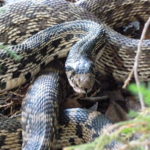


![8 Best Pest Control Companies of 2022 [Reviews]](https://www.lawnstarter.com/blog/wp-content/uploads/2022/01/rsz_1cute-gabe9dba5f_1280-150x150.jpg)
